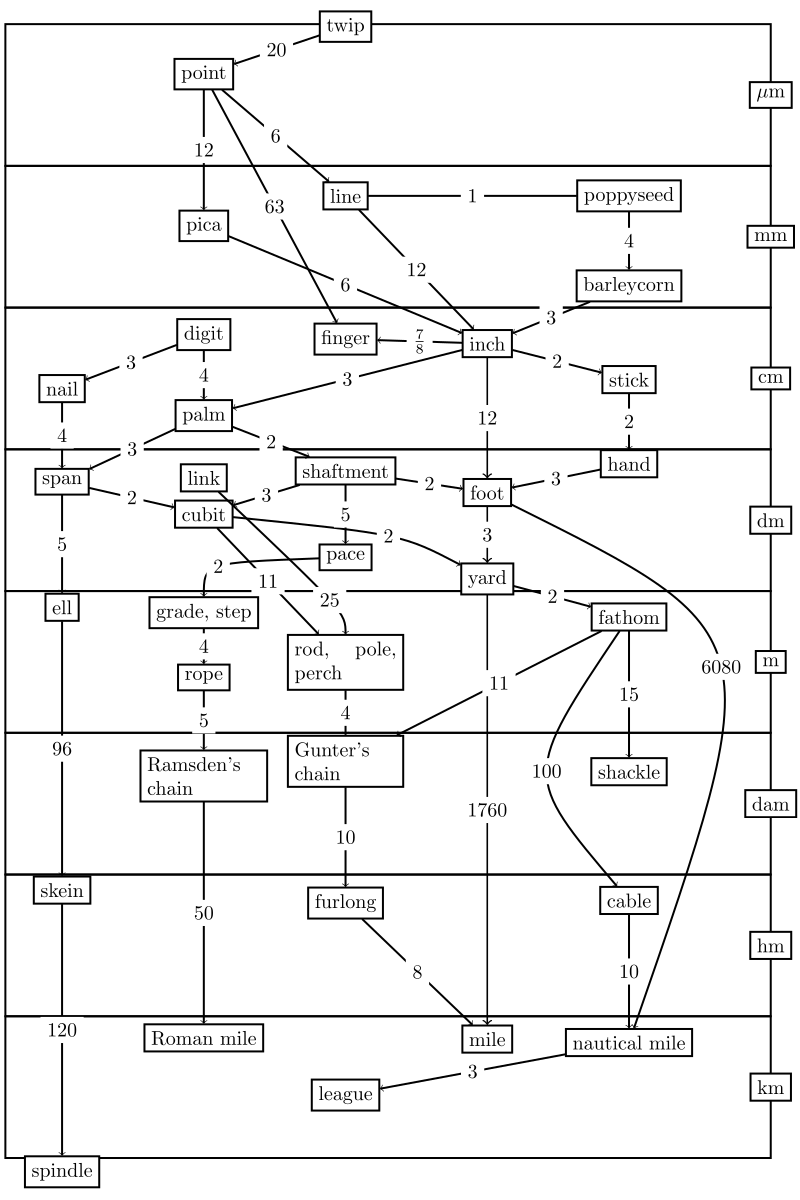You are using an out of date browser. It may not display this or other websites correctly.
You should upgrade or use an alternative browser.
You should upgrade or use an alternative browser.
It's software this time!
- Thread starter EvilDragon
- Start date
bzar
A Commando
Bosbeetle
Terminally lost
That scale stops way to soon and starts not early enough. Theres a lot of life between the planckscale and the twip. And the spindle doesnt even cover one more than a spindle of a parsec.
levi
Still fresh, damnit!
In practical use, the carpenter I watch (Paul Sellers) played around with millimeters, but more recently especially during lockdown went back to imperial entirely. He basically sticks to inches, and reduces that to fractions; 7/8, 1/2. 1/4, 1/8, measurements tend to be done down to a tenth. Polishing I think has always gone to thousandths of an inch, up to I think 32 thousandths of an inch (i.e. a 32th fraction of a thou).
Phlyra
FLOSSing
- Joined
- Jul 25, 2019
- Messages
- 1,517
At university, we were grinding and then polishing XP spectroscopy samples with diamond-encrusted discs graded in microns...In practical use, the carpenter I watch (Paul Sellers) played around with millimeters, but more recently especially during lockdown went back to imperial entirely. He basically sticks to inches, and reduces that to fractions; 7/8, 1/2. 1/4, 1/8, measurements tend to be done down to a tenth. Polishing I think has always gone to thousandths of an inch, up to I think 32 thousandths of an inch (i.e. a 32th fraction of a thou).
Last edited:
Grench
Forum Addict!
- Joined
- Oct 3, 2008
- Messages
- 6,629
In practical use, the carpenter I watch (Paul Sellers) played around with millimeters, but more recently especially during lockdown went back to imperial entirely. He basically sticks to inches, and reduces that to fractions; 7/8, 1/2. 1/4, 1/8, measurements tend to be done down to a tenth. Polishing I think has always gone to thousandths of an inch, up to I think 32 thousandths of an inch (i.e. a 32th fraction of a thou).
In carpentry and cooking, Imperial still has it's advantages in making some things dead simple. The inherent precision in the metric system can simply complicate thins unnecessarily.
Making noodles?
Imperial: 1 level cup of unsifted flour + 1 large egg. Knead until consistent. Roll out to desired thickness and cut. Let dry an hour or two. Cook in near boiling water until done. Noodles will expand to ~4 times thickness during cooking.
Metric: Find a scale. Weigh out 120 grams of flour or measure out 236 ml of flour...
Well, as long as the Users of Metric or Imperial Scalling dont get issues whit thyre own system, and it works for them, then i think im fine whit it,
but on the Global Market, the 2 Systems tend to make some issues if you want to deal whit one who used a diverent system..
but on the Global Market, the 2 Systems tend to make some issues if you want to deal whit one who used a diverent system..
ClockworkCoder
Chaotic Neutral
but on the Global Market, the 2 Systems tend to make some issues if you want to deal whit one who used a diverent system
However it's still a piece of cake when compared to time measurement. DST... m/d/Y... grumble...
Letalis Sonus
Advanced Member
- Joined
- Mar 5, 2009
- Messages
- 1,535
...why would you do that? Do you really think measuring cups with scales printed on them are an imperial-exclusive invention?Metric: Find a scale. Weigh out 120 grams of flour or measure out 236 ml of flour...
Whe have also Measuring Cups whit the Scale of the diverent things printed on (flour until this ---- is 500g .. )..
At my Backery Trainee, i got to become the "Handscale" Skill: you have a lot of breadh dough in your Mixing Mashine, and then it was mandatory to put they out of the machine in par exemple 500g pieces, you also had this scale but if you know how big such a 500g dough is, its much faster as you dont need to put that much dough on the scale after this big piece..
Whe had a Slogan : "Augenmaß und Handgewicht, sind des Gesellen Leibgericht" or something like this..
At my Backery Trainee, i got to become the "Handscale" Skill: you have a lot of breadh dough in your Mixing Mashine, and then it was mandatory to put they out of the machine in par exemple 500g pieces, you also had this scale but if you know how big such a 500g dough is, its much faster as you dont need to put that much dough on the scale after this big piece..
Whe had a Slogan : "Augenmaß und Handgewicht, sind des Gesellen Leibgericht" or something like this..
RZR
Very Active Member
- Joined
- Sep 12, 2019
- Messages
- 113
In carpentry and cooking, Imperial still has it's advantages in making some things dead simple. The inherent precision in the metric system can simply complicate thins unnecessarily.
Making noodles?
Imperial: 1 level cup of unsifted flour + 1 large egg. Knead until consistent. Roll out to desired thickness and cut. Let dry an hour or two. Cook in near boiling water until done. Noodles will expand to ~4 times thickness during cooking.
Metric: Find a scale. Weigh out 120 grams of flour or measure out 236 ml of flour...
That's cool, but let me quote something:
how much energy does it take to boil a room-temperature gallon of water?
Solved completely in imperial please, no cheating here and converting to metric.
A measure system must be useful/usable globally not just for cooking and making chairs... This brings to my memory when, back in college, I saw for the first time the Imperial units used in Solid mechanics
λ the β-Redex Reducer
β-Redex Reducing Member
ISO-8601 is my favourite way of writing Gregorian dates.However it's still a piece of cake when compared to time measurement. DST... m/d/Y... grumble...
gunrock
Very Active Member
- Joined
- Jan 20, 2011
- Messages
- 604
I think @Confuzzled nailed this. Imperial is BS. You only have to get a few units in and it falls apart.
Weights: 16 ounces in a pound, 14 lbs in a stone, 112 pounds in a hundredweight.
Distance: 12 inches in a foot, 3 feet in a yard. Looking at a ruler I have here, sub-inch you have quarter and half inches but also eighths, sixteenths and tenths at opposing ends of the ruler. Way too many fractional ways of subdividing an inch.
No idea where @Robert Taylor gets base-12 from.
Thank god that US money is decimal!
Weights: 16 ounces in a pound, 14 lbs in a stone, 112 pounds in a hundredweight.
Distance: 12 inches in a foot, 3 feet in a yard. Looking at a ruler I have here, sub-inch you have quarter and half inches but also eighths, sixteenths and tenths at opposing ends of the ruler. Way too many fractional ways of subdividing an inch.
No idea where @Robert Taylor gets base-12 from.
Thank god that US money is decimal!
levi
Still fresh, damnit!
In UK Imperial recipes, we never use cups as a measure; instead everything's measured out in pounds and ounces and sometimes even drachms. In imperial, 120g is 4oz 4dm or thereabouts, although many recipe books would round that to either 4oz and specify the use of a small egg, or round it up to 4 1/2oz.Imperial: 1 level cup of unsifted flour + 1 large egg. Knead until consistent. Roll out to desired thickness and cut. Let dry an hour or two. Cook in near boiling water until done. Noodles will expand to ~4 times thickness during cooking.
Metric: Find a scale. Weigh out 120 grams of flour or measure out 236 ml of flour...
In any case, it made the conversion to metric grammes slightly less daunting.
For some value of fun, I used to order a quarter pound of ham at the deli counter in the supermarket. You should have seen the little dears faces!
Grench
Forum Addict!
- Joined
- Oct 3, 2008
- Messages
- 6,629
...why would you do that? Do you really think measuring cups with scales printed on them are an imperial-exclusive invention?
Yes, I realize that there are metric measuring devices. You are missing the actual point though. Where Imperial units were derived from real-world use instead of mathematical convenience, the ratios are simple and easy to perform.
1 cup flour + 1 egg = noodles. Note that it is 1:1. Convenient and easy to remember. The 'cup' may as well have been derived as 'how much flour I need for one good sized egg'.
1 cup of food = minimum of how much 'food' (gruel) a person should have for each meal, if you don't like that person much. (prison rations, marching armies, soup kitchens, etc.)
2 cups = 1 pint = how much good / heavy beer a person needs to get a satisfied background buzz on. It is more satisfying to simply 'order a pint' than it is to 'order a half liter', even though 500ml > 1 pt.
For anything scientific or needing to be -exactly- communicated, the metric system is king. For simplicity and social measuring - Imperial.
Letalis Sonus
Advanced Member
- Joined
- Mar 5, 2009
- Messages
- 1,535
Fun fact: metric measuring cups usually also include imperial scales.1 cup flour + 1 egg = noodles. Note that it is 1:1. Convenient and easy to remember.
Recipes always round up or down to the next convenient number anyways, which makes imperial cups actually inferior because you'll more likely deviate even more from the optimal ratio for the perfect noodles.
levi
Still fresh, damnit!
Only in the US. In the UK, thanks largely to our larger sized gallons, our pints are bigger too, so actually a UK pint is over 12% more than 500ml.even though 500ml > 1 pt.
Confuzzled
Very Active Member
- Joined
- Oct 1, 2018
- Messages
- 302
No, just extremely good at procrastination.clearly many of you are immensely bored.
need new toy asap
Kev2442
Still French
No, just extremely good at procrastination.



